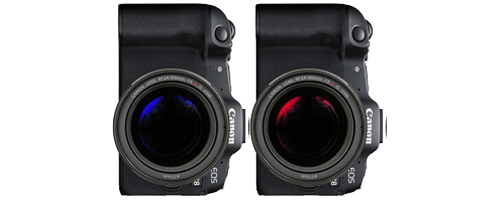
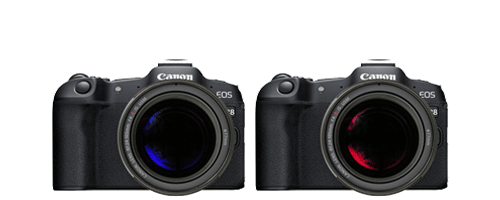
capturing real digital stereoscopic photographs
 My Twin Rigs - Stereoscopy 139 Extract
My Twin Rigs - Stereoscopy 139 Extract
(cameras, two preferably, one if you must)
Capturing real digital stereoscopic photographs of subject matter that contains movement requires a pair of synchronised digital cameras or a single digital camera with two lenses.
It all comes down to how much control you want over the capture process. Dedicated commercial digital stereo cameras are almost always compact cameras with functional limitations and compromises as compared to paired medium to high end mirrorless cameras. My own preference is to use a pair of medium to high end mirrorless cameras for portrait and landscape photography and a single medium to high end mirrorless camera with a dedicated 3D lens for close-up and macro photography. Whenever I use a dedicated commercial digital stereo compact camera, I am always reminded of why I prefer otherwise.
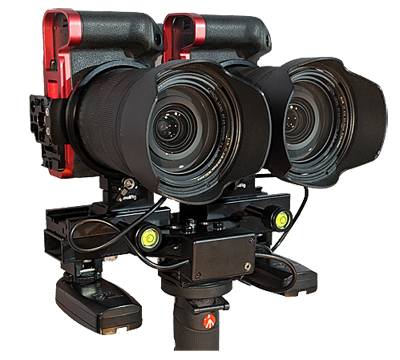
Paired Canon EOS R8's for portrait and landscape photography.
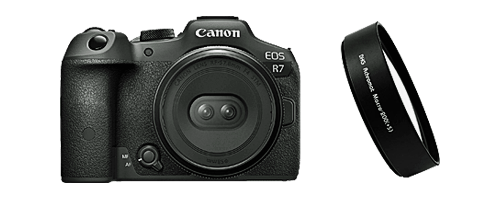
Canon RF-S 7.8mm f/4 STM Dual Lens on a Canon EOS R7 +/- a Marumi Achromatic Macro 200 +5 72mm adaptor for close-up and macro photography.
You can use a smartphone to capture a single digital photograph and a depth map which are subsequently used to create an artificial digital stereoscopic photograph using artificial intelligence to make up (concoct) the missing parts of either photograph but it will always be inferior.
You can use a single digital camera with one lens or smartphone to capture real digital stereoscopic photographs where nothing moves using what is called the 'cha-cha' approach. But that means no wind, no moving water, no moving subjects, your options have restrictions.
If you use the 'cha-cha' approach, you must pay absolute attention to keeping your camera or smartphone facing exactly the same direction between captures, the only movement should be a controlled sideways shift of somewhere between 6 to 7cm. Attempting to do this handheld in standing is an acquired skill.
Just because a smartphone has more than one lens in an array does not mean it is natively capable of capturing real digital stereoscopic photographs. That array io most probably composed of independent lenses for macro (close up), portrait (normal) or telephoto (zoom) photography. They all have different focal lengths and using the photographs captured by two of them has limitations and requires suitable software.
Regardless of what you use, the lenses should almost always be laterally separated, not vertically separated. Your brain will struggle to see depth in vertically separated photographs unless you rotate the captured photographs and tip the world on its side.
(interaxial separation, not too far)
Interaxial separation is the distance between the centres of two camera lenses, whereas interocular separation (or interpupillary distance) refers to the distance between the centres of the human eyes. This distance is typically accepted to be an average of 65mm (roughly 2.5 inches) for a male adult, with the normal range being between 54 and 74 millimetres.
The interaxial separation of the centres of your two camera lenses should stay as close as possible to this value. Wider separations exaggerate the perceived depth and push the closest object you can comfortably capture further away than the usual 2 meter minimum. If you want to get comfortably closer, you need to close the distance between the centres of two camera lenses accordingly. A separation of 25mm lets you come as close as 50cm.
| Interaxial separation (mm) | Example | Good for... |
|---|---|---|
| 140 | Canon EOS R* in Landscape | Anything that's not closer than 10m, ideal for Landscapes |
| 120 | Canon M* in Landscape | Anything that's not closer than 6m, ideal for Landscapes |
| 100 | Canon EOS R* in Portrait | Anything that's not closer than 3m |
| 80 | Canon EOS M* in Portrait | Anything that's not closer than 2.5m |
| 60 | Sony RX0 II | Anything that's not closer than 1.5m |
| 50 | XREAL Beam Pro | Anything that's not closer than 1.0m, not ideal for Landscapes |
| 30 | Panasonic 3D1 | Portraits as close as 50cm, not ideal for Landscapes |
| 11.8 | Canon RF-S 7.8mm f/4 STM Dual Lens on a Canon EOS R7 | Macro - Flowers |
| 11.8 | Canon RF-S 7.8mm f/4 STM Dual Lens with a Marumi Achromatic Macro 200 +5 72mm adaptor on a Canon EOS R7 ** | Close Macro - Insects |
| 10 | Panasonic 3D Lens | Macro - Flowers |
| 10 | Panasonic 3D Lens with spacers ** | Close Macro - Insects |
** you can get closer
(convergence maybe, divergence never)
What never happens to your eyes in the natural world is divergence, so never let your cameras angle outward. If anything, they should be pointed straight ahead. In carefully controlled circumstances they can point carefully inward, but if your backgrounds cross over when you focus on the closest object, make those backgrounds comfortably fuzzy (out of focus).
(the stereo window is your canvas)
Simply put, the 'stereo window' refers to the imaginary canvas on which you paint your stereoscopic scene (like a television screen). Objects in your stereoscopic scene can be behind or outside the window (positive parallax), on the window (zero parallax), or inside the window, meaning between you and the window (negative parallax). Normally you want your objects to be behind or outside the window. As a general rule any objects inside the window should not touch the sides of the window. Objects will have different horizontal offsets in your photographs (parallax) depending on their depth in the stereoscopic scene.
(non-horizontal disparities are issues to avoid)
Anything other than horizontal disparity between the objects in your left and right eye photographs are a problem. Vertical, rotational, zoom, keystone or temporal disparity will cause eye strain.
It is very important to use the same type of camera, same type of lens and exactly the same camera settings (white balance, shutter speed, aperture, resolution, zoom, etc.). Any differences will cause a disparity.
(flash photography)
Capturing real digital stereoscopic photographs with a single flash unit creates differential shadowing between the left and right photographs which causes retinal rivalry (aka disparity) in the eyes of the viewer. You need to use 2 or more flash units mounted at least twice the distance between the centres of your two camera lenses apart to remove the offending shadows. Syncing two or more flash units and two cameras is tricky at the best of times and not recommended for the inexperienced.
Using flash with a single camara on a Slide Bar: The flash must stay stationary and no not move with camera. If moved with the camera, shadows will appear pseudoscopic.
Single Central Flash: If the flash is centred between the lenses, it casts shadows where the left eye sees the left shadow, and the right eye sees right shadow. In real life light never comes between the eyes. It comes from above, forming shadows in the same side.
Dust Halos: If the flash is very close to the line of sight of the lenses, small particles in the air will be recorded as out of focus, distracting areas, known as 'dust halos'.
Red Eye: If the flash is very close to the line of sight of the lenses red eye can be more of a problem.
Flash with Twin Cameras Rigs: You need to synchronize the camera exposures of both cameras and the flash exposure. Use a flash connected in series to both cameras or a flash trigger delay.
(the 1 in 30 'rule')
The 1 in 30 'rule' is a commonly adhered to principle that has been used for decades by stereographers. It basically states that the interaxial separation should be no wider than 1/30 of the distance from your camera to the closest object.
Interaxial separation x 30 = minimum object distance.
The 1 in 30 'rule' is best followed when your effective viewing screen size is less than 65 inches wide, your cameras were positioned parallel to each other, and your photographs were all taken with the background at infinity (included the horizon).
The 1 in 30 'rule' is not absolute.
There are many occasions where the 1 in 30 'rule' has been violated and yet the image works. If a person viewing the image can look around the image at the various objects without visual disturbance, adherence to the 'rule' is of no concern.
(underwater camera rig)
The visual acuity of an air-optimised camera lens is severely adversely affected by the difference in refractive index between air and water if it is in direct contact with water. Provision of an airspace between the lens and the water can compensate, but has the side effect of scale and distance distortion. At very short range in clear water distance is underestimated, in accordance with magnification due to refraction through the flat lens of the 'mask', but at greater distances, greater than arm's reach, the distance tends to be overestimated to a degree influenced by turbidity. Add to this that underwater objects are less visible because of lower levels of natural illumination caused by rapid attenuation of light with distance passed through the water. More distant objects are also blurred by the scattering of light between the object and the camera lens which results in lower contrast. Underwater stereoscopic camera rigs using air-optimised camera lenses should use a narrower interaxial distance due to closer objects offering the best stereoscopic subject matter from both a technical and practical viewpoint.
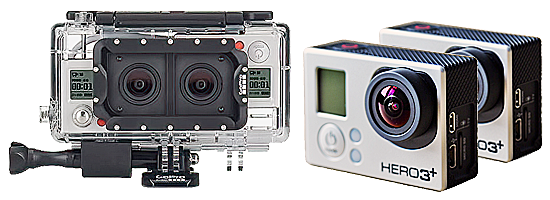
The GoPro Dual Hero System is waterproof to 197'/60m and the tandem housing holds two HERO3+ Black Edition cameras (not silver or white editions) at an interaxial distance of 33mm. The cameras can be configured to record 4k15fps, 2.7k30fps, 1440p48fps, 1080p60fps 3D videos and/or 12MP photographs. A synchronization cable plugs into the rear HERO Port on both cameras to join them together for perfect (gen-locked) synchronization.
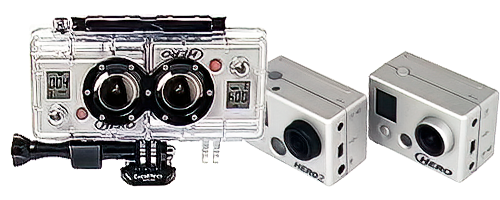
There is an older GoPro 3D HERO System for GoPro HERO and HERO2 Cameras that is restricted to 1080p30fps video and 11MP photographs. Each type of tandem housing only suits the specified cameras without exception. The captured content from each camera was nominally converted to 3D using the free GoPro Cineform Studio editing software (but other products can be used).
Note: GoPro discontinued support for GoPro Cineform Studio in 2019. However, you can still download GoPro studio software from some 3rd Party websites.
(your camera rig)
Putting together an effective stereoscopic camera rig is always a compromise situation and is a topic of constant discussion and debate amongst stereographers. As with any photographic exploit, you do get what you pay for, but there are some foundational considerations.
Try and find a pair of cameras that you can mount in a way that brings the effective interaxial separation between the centres of two camera lenses as close to the average interpupillary distance of 65mm as possible.
 side-by-side |
 offset |
 z config |
 base-to-base |
 top-to-top |
 top-to-base |
The second fundamental, unbreakable requirement, is that if you want to capture real digital stereoscopic photographs of subject matter that contains movement, you need a pair of cameras that synchronise down to at least the 1ms level in normal operation.
The following table is an applicable guide.
| Synch error (ms) | Rating | Good enough for... |
|---|---|---|
| 0.000 | 'Perfect' | Anything |
| 0.001 | 'Almost Perfect' | Almost anything |
| 0.01 | 'Miraculous' | Very, very fast objects |
| 0.1 | 'Excellent' | Fast objects like flying bees or flying insects |
| 0.2 | 'Superior' | Fast sports and action scenes, flags in the wind |
| 0.25 | 'Very Good' | Flying birds |
| 0.5 | 'Good' | Moving objects like cars or trains, flowing water |
| 1 | 'Sufficient' | Moving leaves in the wind, fountains |
| 2 | 'Bad' | Walking people |
| 5 | 'Insufficient' | Slow-moving objects like snakes |
| 10 | 'Inadequate' | Very slow-moving objects like snails |
| 10+ | 'Not Acceptable' | Non-moving objects |
The third fundamental, unbreakable requirement, use a two-step focus then shutter release workflow in capturing your photographs. Both cameras need to have achieved focus on the same objects before you release the shutters. You can use suitable wired or wireless remote controls to achieve this. After that, the normal settings that dictate better captured photograph quality apply.

Wireless remotes (with two receivers) can be a good way to trigger compatible cameras to avoid getting tangled in cables.
(Paired Sony RX0 ii Cameras)

Two Sony RX0 ii cameras paired using a Sony VMC-MM2 Release cable mounted in shortened aluminium cages attached to a 140mm bar. The cameras have a 60mm interaxial separation, a 0.5ms sync error and are ideally suited for capturing real digital stereoscopic photographs with a minimum of fuss.
(proven examples)
Canon compacts compatible with Stereo Data Maker (SDM) (s95, s100)
Canon digital mirrorless compatible with Stereo Data Maker (SDM) (eos m3, eos m10)
Canon 35mm Digital SLRs with paired wireless/wired remotes (1100D, 1200D)
Sony digital mirrorless with multiport connectors (a6000, rx0, rx100, rx10, rx1)
Canon EOS M3 with Stereo Data Maker and wired remotes
Canon EOS M6 II with paired wireless/wired remotes
Canon EOS R* with paired wireless/wired remotes
(unreliable examples)
Panasonic/Olympus M4/3 cameras with paired wireless/wired remotes (roaming sync)
Samsung NX1000/1100 with paired wireless/wired remotes (unstable colour variance)
Canon EOS M6 mirrorless with paired wireless/wired remotes (roaming sync)
Canon EOS M mirrorless with paired infrared remotes (roaming sync)
...
Jeff Ewen 3D - creating real digital stereoscopic photographs.
Contact me by clicking here.